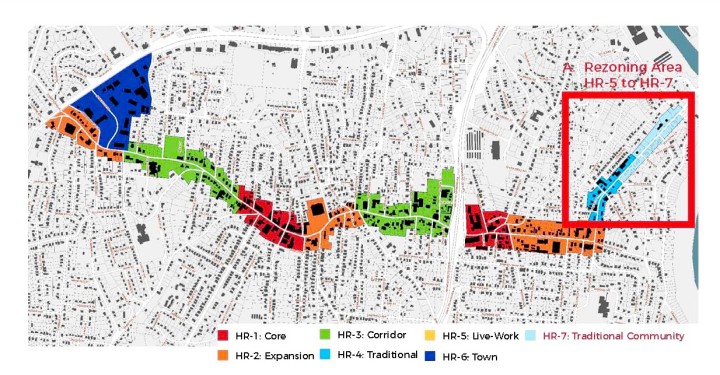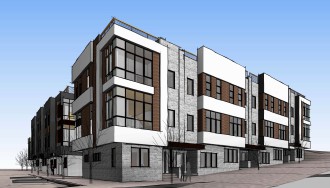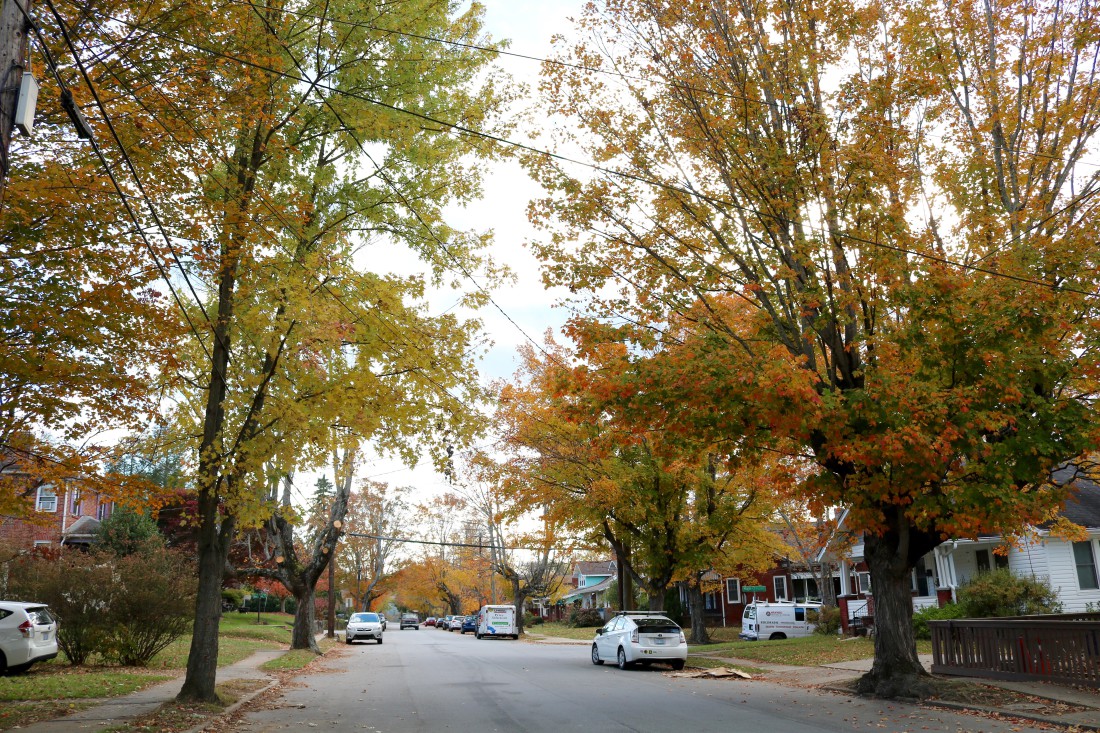Homeowners on Vermont Avenue in West Asheville see their neighborhood as a quiet, special residential pocket of the city — and they intend to keep it that way.
About 20 Vermont Avenue residents came to the Nov. 1 Planning and Zoning Commission meeting to stop a part-time resident from opening an art gallery in a house on the street. Tracey Burnette of Dawsonville, Ga., applied for conditional zoning so she can operate a folk art gallery from the house she owns at at 8 Vermont Ave.
Burnette said the art she plans to sell “fits Asheville like a glove” and her property is so close to the commercial area on Haywood Road that she doesn’t feel her art gallery would interrupt the neighborhood. “I am just trying to come up here and sell some of my art in an easy, welcoming, respectful way,” she said. “No way am I trying to run over anybody, take away from anybody.”
Jane Kennedy said she spoke on behalf of about 200 people who signed a petition to keep Vermont Avenue residential, worrying that allowing commercial activities at 8 Vermont Ave. would lead to further business encroachment down the street. “Living on Vermont is a blast,” she said. “We get to benefit from the revitalization of the corridor, walking to meals and having so much at our disposal.” But Kennedy said residents already complain of a scarcity of parking and noise issues and don’t want those problems to be exacerbated.
Commissioner Guillermo Rodriguez said he would hate to see business intruding on a peaceful, tree-lined community. “It’s a very unique part of the neighborhood because it is so close to the Haywood core but it’s that transition into the traditional neighborhood,” he said. “You look down Vermont, it is one of those classic streetscapes where you have arching trees and sidewalks and consistent side yards and front yards.”
Alaya Dickinson, a 16-year resident of Vermont Avenue, said it was very easy to collect signatures against the proposed use of a house on the street for a retail art gallery. She credited the unique nature of the neighborhood with inspiring people to want to protect it. “Vermont Avenue has got some kind of magic,” she said. “There’s something that’s just really kind of old-fashioned and sacred about it.”
Planning and Zoning Commission Chair Laura Berner Hudson said there’s a “housing crisis” right now in Asheville and granting this request would take one more home out of the housing stock. “I think there’s definitely a place for you to sell your art in Asheville,” she told the applicant. “But potentially not in a residential neighborhood. … I don’t quite see it as a home-based business. I kind of think it’s a business.”
The commission voted to deny the request. It now must go to City Council for final consideration.

Long-term planning, short-term rentals
As Asheville scrambles to deal with an intensifying issue of short-term rentals, city boards appear to be taking divergent stances on how to handle it.
In its past few meetings, City Council has indicated a desire to rein in the illegal practice of renting out whole houses or units for fewer than 30 days via vacation rental sites such as Airbnb and VRBO. It asked city staff to look more closely at how many STRs are operating in the city as it leans toward stricter enforcement of its ban on such rentals in residential districts and a better understanding of how many exist in commercial districts, where they are allowed. Council also directed the Planning and Zoning Commission to consider removing short-term rentals as a permitted use from commercial and mixed-use areas in the River Arts District and along Haywood Road as part of form-based zoning codes in those neighborhoods.
In contrast, Asheville’s Planning and Zoning Commission has twice voted to recommend that City Council allow lodging uses, first in the RAD and then in the Haywood Road corridor. July’s Council meeting saw a lengthy debate on the pluses and minuses of short-term rentals in the River Arts District, but the elected officials ultimately voted to ask P&Z to remove lodging of 20 rooms or fewer from the code in most of that area. In response, P&Z voted in September to retain lodging as a permitted use in four of seven proposed zones in the RAD. Council was slated to hear the issue again on Oct. 24, but the matter was continued to its Nov. 14 meeting so that Mayor Esther Manheimer could consult with the Bar Association on whether she should recuse herself.
Similarly, in early October, City Council sent the Haywood Road form code back to the Planning and Zoning Commission to consider removing lodging of 20 rooms or fewer as a permitted use in the district. On Nov. 1, P&Z decided that short-term rentals should be allowed in the Haywood Road area, sending the final decision back to City Council.
Comments from the public and members of these city boards show that two opposing viewpoints lie at the heart of this issue. On one hand is the idea that whole-house, short-term rentals decrease the available housing stock for long-term residents looking to rent. On the other is the belief that that property owners have the right to supplement their incomes with short-term rentals and that STRs help bring tourists to districts that need that economic activity.
Members of both P&Z and City Council have stated a need for Asheville to explore this matter further. But Council’s decisions tend more toward trying to slow the spread of STRs as the city figures out what to do about them, while P&Z puts more weight on the concerns of businesses and homeowners who say STRs are a boon. At its most recent meeting, P&Z also leaned against banning STRs on Haywood Road due to the fact that the existing form-based code was created through lengthy and in-depth community input.

Hudson summed up the issue at the meeting. “It seems like a lot of this is precipitated by the rise of short-term rentals, not necessarily actual hotel use, and it’s more being driven by the loss of housing than it is allowing lodging and tourism in these areas,” she said.
Hudson added that the Haywood Road form-based code, which was adopted in 2014, pre-dated the concerns over vacation rentals. “That was before the proliferation of short-term rentals flooded our market and became this new kind of use that we’re grappling with throughout the city,” she said.
The matter before P&Z on Nov. 1 was twofold: one, to create a new Haywood Road district (HR-7) that would allow for a mix of residential and commercial uses except that it would not permit lodging facilities; two, to consider the appropriateness of lodging facilities along the entire Haywood Road corridor.
Austin Walker, president of the West Asheville Business Association, asked the commission not to support disallowing lodging of 20 rooms or fewer in the Haywood Road area. He said WABA was very involved in the long visioning process that went into creating the Haywood form-based code. “The intent of it is spelled out very clearly, and lodging does contribute to the intent and the vision of the corridor,” he said. “We’re getting kind of caught up in what’s happening in the neighborhoods, which is really a separate issue altogether. This is a commercial corridor, and the lodging will be very supportive of the businesses that are exploding over there.”
James Boren of Green Earth Developments said he often hears owners of his company’s custom-built homes in West Asheville raving about how much money they’ve made by using their houses as legal vacation rentals. He wants the city to make it clear that future projects in the neighborhood will be allowed to be used as short-term rentals. “We are going to do nine small condos there, but we need the ability to shift that to lodging in the future if the market calls for that,” he told the Planning and Zoning Commission. “As a small development company, we can’t handle the mixed signals that we get.”
Commissioners Karl Koon and Joe Archibald agreed with WABA’s argument that the process for the form-based code had been in the works for years and shouldn’t be thrown a monkey wrench now. “I think it’s been going on for so long, I think to change that at the last minute would not be a good idea,” Archibald said.
Hudson suggested the city’s planning staff take a comprehensive look at STRs throughout Asheville as the city is being forced to rapidly respond to the “gold rush mentality” of short-term rentals. “Some argue that yes, it’s a great business opportunity and it brings folks to our restaurants and retail shops,” she said. “But these people don’t vote, they don’t go to school, they don’t go to dry cleaners, they don’t get their cars fixed and do things that residents do. … Do we want tourists in every nook and cranny of our city?”

The commission voted 5-1 to recommend that a new HR-7 district be created along Haywood Road, but that the permitted uses that exist now in the code remain as is for lodging units of 20 or fewer. Jim Edmonds was the sole “no” vote.
Home run for condos near stadium
The Planning and Zoning Commission approved a proposal to build 17 townhomes in multiple three-story buildings at 66 and 72 McCormick Place, which is currently a vacant lot adjacent to McCormick Field.
Assistant Planning Director Alan Glines said the project still must go before the city’s Technical Review Committee.




Is there really a nook or cranny left? On Halloween, VT Ave. is the most visited road around in West AVL. Kids everywhere, a total nightmare. But a few old tourists checking out some art? Aw heck naw.